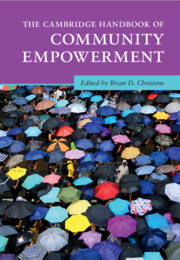Book contents
- The Cambridge Handbook of Community Empowerment
- Cambridge Handbooks in Psychology
- The Cambridge Handbook of Community Empowerment
- Copyright page
- Contents
- Figures
- Tables
- Contributors
- Building Community Power
- Part I Organizing and Activism
- Part II Participatory Governance
- Part III Civil Society and Coalitions
- Part IV Enterprise
- Part V Participatory and Community Arts
- Part VI Education and Engaged Research
- 20 Action Civics
- 21 Gender–Sexuality Alliances
- 22 Youth Participatory Action Research in School Settings
- 23 Community-Based Education
- 24 Community-Engaged Research
- Concluding Thoughts on Building Community Power
- Contributor Details
- Index
- References
23 - Community-Based Education
from Part VI - Education and Engaged Research
Published online by Cambridge University Press: 18 April 2024
- The Cambridge Handbook of Community Empowerment
- Cambridge Handbooks in Psychology
- The Cambridge Handbook of Community Empowerment
- Copyright page
- Contents
- Figures
- Tables
- Contributors
- Building Community Power
- Part I Organizing and Activism
- Part II Participatory Governance
- Part III Civil Society and Coalitions
- Part IV Enterprise
- Part V Participatory and Community Arts
- Part VI Education and Engaged Research
- 20 Action Civics
- 21 Gender–Sexuality Alliances
- 22 Youth Participatory Action Research in School Settings
- 23 Community-Based Education
- 24 Community-Engaged Research
- Concluding Thoughts on Building Community Power
- Contributor Details
- Index
- References
Summary
In their rich history, community-based educational spaces (CBESs) have afforded communities room to build young people’s critical consciousness, to organize for social change, and to create learning environments that foster a political – and, in certain respects, a more meaningful – education. Broadly speaking, CBESs meet the specific needs of communities, such as providing access to food and opportunities for learning and identity exploration. In this chapter, the authors overview the scholarly literature related to CBESs and their power-building features that facilitate community power and psychological empowerment processes, as well as the tensions in CBESs that can hinder power-building. Amid this discussion, the authors highlight Urban Underground, a CBES in Milwaukee, Wisconsin, as an organization that exemplifies the humanizing education, youth empowerment, and power-building possible within CBESs. Through this chapter, the authors contend that CBESs have the power to bring about social change in their communities and spur transformative change for those they serve.
- Type
- Chapter
- Information
- The Cambridge Handbook of Community Empowerment , pp. 580 - 605Publisher: Cambridge University PressPrint publication year: 2024

